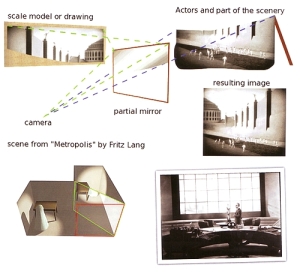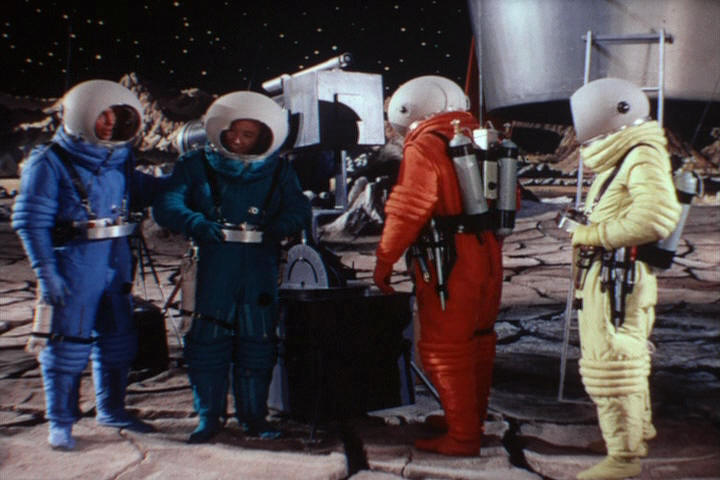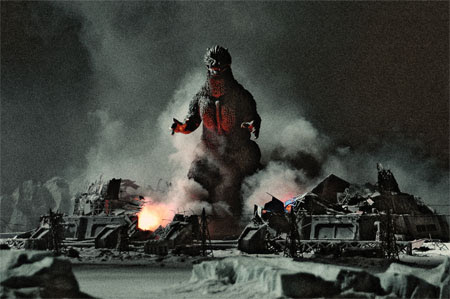The Magic of METROPOLIS (Fritz Lang, Germany, 1927)
The Magic of METROPOLIS (Fritz Lang, Germany, 1927)
Made at the height of the German Expressionist movement in the Weimar Republic, Metropolis almost bankrupted German studio UFA, costing more than 500,000 Reichsmarks (at least $1 million in 1927). But as a result, Metropolis is one of the most spectacular and technically ground-breaking movies of all time. Set in the far future (the year 2000!), the film imagines a  massive, industrially driven city, split between the privileged industry leaders and their sons who live lives of leisure in pleasure gardens and sports stadia, and the oppressed proletariat, who live underground and are treated no better than lobotomized robots. In addition to visualizing such a city–inspired in part by director Fritz Lang’s first visit to New York City–Lang also imagined an actual robot, who through some crypto-science and movie magic is transformed into a woman indistinguishable from her human model (except for being oversexed–watch out for her Art Deco striptease scene!). George Lucas has admitted that C3PO in Star Wars was directly inspired by Lang’s character.
massive, industrially driven city, split between the privileged industry leaders and their sons who live lives of leisure in pleasure gardens and sports stadia, and the oppressed proletariat, who live underground and are treated no better than lobotomized robots. In addition to visualizing such a city–inspired in part by director Fritz Lang’s first visit to New York City–Lang also imagined an actual robot, who through some crypto-science and movie magic is transformed into a woman indistinguishable from her human model (except for being oversexed–watch out for her Art Deco striptease scene!). George Lucas has admitted that C3PO in Star Wars was directly inspired by Lang’s character.
Brigette Helm, who played both the virginal Maria and her robotic doppelganger, was only 18 years old when Metropolis started filming. Metropolis also features a definitive performance by Rudolf Klein-Rogge as the mad scientist Rotwang, one of many inspirations for Kubrick’s Dr. Strangelove. (Both have prosthetic/mechanical hands–a trope that shows up in Star Wars too).
But despite their best efforts, the cast is ultimatel y overshadowed by the special effects. Massive scale-model sets were built to convey the scope of the futuristic city with its layered overpasses and airplane traffic. Each of the 300 automobiles in the photo above were moved by hand in a frame-by-frame stop-motion process. The production also took advantage of Eugen Schufftan, who invented “the Schufftan process,” which uses mirrors to insert live-action footage of actors into the same shot as miniatures. Multiple exposure was also used to combine many images in one (as in the images of eyes ogling the robot Maria)–this was done all in-camera, rewinding the same film over and over again to get each additional piece. The film took more than 310 days to shoot and required hundreds of technicians.
y overshadowed by the special effects. Massive scale-model sets were built to convey the scope of the futuristic city with its layered overpasses and airplane traffic. Each of the 300 automobiles in the photo above were moved by hand in a frame-by-frame stop-motion process. The production also took advantage of Eugen Schufftan, who invented “the Schufftan process,” which uses mirrors to insert live-action footage of actors into the same shot as miniatures. Multiple exposure was also used to combine many images in one (as in the images of eyes ogling the robot Maria)–this was done all in-camera, rewinding the same film over and over again to get each additional piece. The film took more than 310 days to shoot and required hundreds of technicians.
Lang is notable not only for his visual genius, but also for his “legendary cruelty” toward his cast. According to Frank Miller for TCM:
Whether it was just perfectionism or a sadistic streak (which could be mirrored in the violence in his films), Lang drove cast and crew relentlessly, with little regard for their health or safety. He spent two days rehearsing and shooting a simple scene in which Frohlich collapses at Helms’ feet. By the time he was finished, the actor could barely stand. During a fight scene, Frohlich dislocated his thumb, but Lang only gave him a half-hour to recover going back to work on the scene. During the flooding of the worker’s living areas, he kept directing the extras and children to throw themselves at the biggest water jets until they were almost drowned. When it came time for the workers to burn the robot Maria at the stake, he insisted on using real flames for the shots of Helm. At one point, her dress accidentally caught fire.
The original conception for Metropolis was a collaboration between Fritz Lang and his (second) wife, Thea von Harbou. Lang has claimed that Josef Goebbels offered to make him the head of UFA, directing films for Adolf Hitler (whose favorite film was reported to be Metropolis). According to the legend, Lang fled Germany by train that same night, in fear because of his Jewish heritage. (Although raised Roman Catholic, his mother was Jewish.) Von Harbou, a Nazi sympathizer, did not follow and they divorced, ending their decade-long collaboration. He eventually emigrated to Hollywood, where he directed such influential noir films as Fury and The Big Heat.
LINKS:
- This website, from Kino Lorber, the distributor of the most recent restoration of Metropolis, is a fantastic resource for information about the restoration, the production of the original film, and the various versions it has taken over the years. Be sure to check out the photo gallery to look at photos from behind the scenes (including the ones above). There is also a list of the inserted scenes that were taken from the footage thought to be lost.
- Gunther Rittau, who shared camerawork for Metropolis with Karl Freund, wrote this article about the special effects for the film in a 1927 issue of Cinefantastique.
- The video below explains the Schufftan process and some of the other notable special effects in the film.


